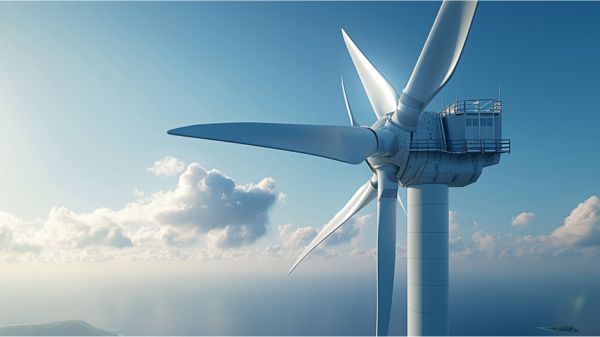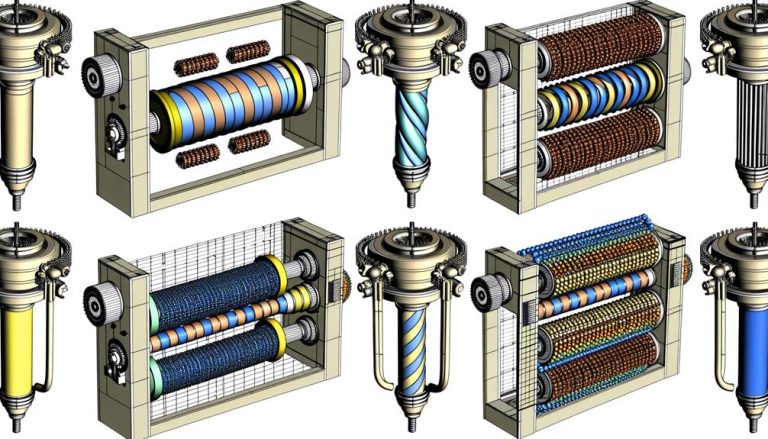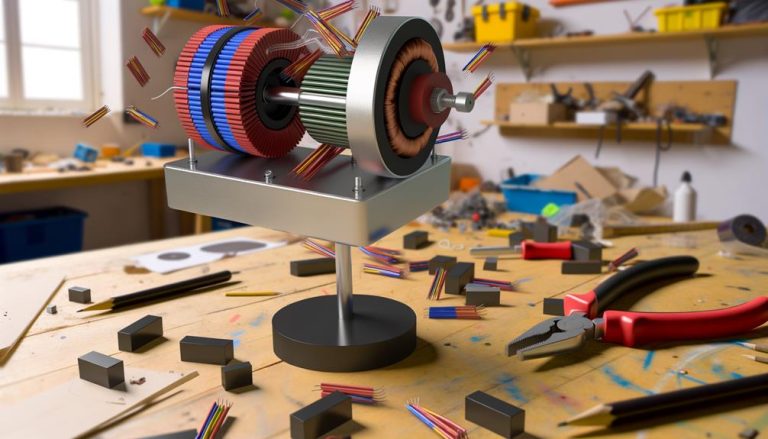Imagine a world where the power of magnets can be harnessed to propel us towards a clean and sustainable future. In this realm, magnet-powered generators are the silent heroes, quietly working behind the scenes to revolutionize renewable energy.
From wind turbines standing tall against the horizon to the charging stations of electric vehicles, these generators are the backbone of various applications in the realm of clean energy. But their impact doesn’t end there. In fact, there are eight remarkable applications that await your discovery, each one holding the promise of transforming the way we generate, store, and distribute power. Are you ready to explore the awe-inspiring possibilities that lie within?

Key Takeaways
- Magnets play a crucial role in wind turbines and hydropower systems, improving efficiency and reducing maintenance costs.
- Integration of magnets with solar PV systems enhances energy conversion and efficiency.
- Magnets can optimize geothermal technology, increasing its efficiency and lifespan.
- The use of magnets in holding applications and off-grid power solutions contributes to the reliability and stability of renewable energy systems.
Wind Turbines
Wind turbines, powered by strong rare-earth magnets, efficiently convert the energy from spinning blades into electricity. These modern wind turbines play a crucial role in renewable energy generation by harnessing the power of the wind to produce clean and sustainable electricity. The use of magnets in wind turbines is essential for their efficient operation.
Permanent magnet synchronous generators (PMSGs) in wind turbines can operate at low speeds without the need for a gearbox. This not only improves reliability but also reduces maintenance costs and increases overall efficiency. The magnets used in these generators, specifically neodymium magnets, possess temperature stability and optimal magnetic properties, ensuring maximum efficiency in converting wind power into electricity.
The role of magnets in wind turbines extends beyond the generators. Magnetic gearboxes, for example, optimize the kinetic energy of water in hydropower applications, leading to cost reductions. Additionally, wind turbines aren’t the only beneficiaries of magnet-powered generators. Tidal energy, a form of hydropower, utilizes gravitational forces to generate electricity from large bodies of water, further expanding the applications of magnet-powered generators.
Hydropower Systems
Hydropower systems harness the kinetic energy of flowing water to generate electricity through electromagnetic induction. This renewable energy source has gained prominence due to its efficiency and sustainability. Here are some key facts about hydropower systems:
- Hydropower systems utilize the force of flowing water to spin turbines, which are connected to generators that produce electricity.
- Hydroelectric power plants can be built in various settings, such as rivers and dams, making use of the abundant water resources available globally.
- Magnets play a crucial role in hydropower systems by creating a magnetic field that induces electric current in the generator coils.
- The efficiency of hydropower systems is high, with conversion rates ranging from 80% to 90%, making it one of the most effective methods of power generation.
- Tidal energy, a form of hydropower, harnesses the gravitational forces of the moon on large bodies of water to generate electricity, providing another avenue for renewable energy production.
Adams experts can provide magnets optimized for temperature stability and magnetic properties in hydropower applications. By using magnetic gearboxes, the kinetic energy or velocity of water in hydropower systems can be optimized, leading to cost reductions.
With its reliance on the continuous flow of water, hydropower systems offer a reliable and sustainable source of electricity for a liberated future.
Solar PV Systems
Solar PV systems offer a high level of efficiency, making them an attractive option for generating electricity from sunlight. These systems have become increasingly cost-effective, allowing for widespread adoption in various settings.
Efficiency of Solar PV
The efficiency of solar PV systems is a crucial factor in determining the economic viability and energy output of a solar power installation. High-efficiency solar PV systems can generate more electricity with the same amount of sunlight, making them more cost-effective.
Factors such as the type of solar cells used, temperature, and the angle and orientation of the solar panels can affect the efficiency of solar PV systems. Advancements in solar cell technology, such as multi-junction solar cells and anti-reflective coatings, are being developed to improve the efficiency of solar PV systems.
Maximizing the efficiency of solar PV systems is critical for maximizing the energy output and economic viability of solar power installations.
Cost-Effectiveness of Solar PV
When considering the economic viability of a solar power installation, it’s important to evaluate the cost-effectiveness of solar PV systems, taking into account their reduced energy bills, low maintenance requirements, and long lifespan.
Solar PV systems are considered highly cost-effective due to these factors. The declining cost of solar panels and the increasing efficiency of solar PV technology contribute to their cost-effectiveness. As a result, solar PV systems offer a high return on investment, especially when combined with incentives, rebates, and net metering programs.
Additionally, the scalability and modularity of solar PV systems allow for tailored installations based on energy needs and budget, further enhancing their cost-effectiveness.
Furthermore, solar PV systems have a low environmental impact, reducing externalities and ensuring long-term sustainability.
Integration With Existing Systems
Integration with existing solar PV systems involves incorporating magnet-powered generators to optimize energy production. By combining the power of magnets with solar panels, a more efficient energy conversion process can be achieved. Here are five key points to consider:
- Magnets in solar panels can enhance the absorption of solar energy, increasing the overall output of integrated systems.
- The use of magnets in solar PV systems can improve the efficiency of the sputtering process, resulting in higher energy production.
- Magnetrons, equipped with permanent magnet assemblies, can be specifically designed to work in tandem with solar PV systems, maximizing energy utilization.
- Integrating magnet-powered generators with solar panels showcases the adaptability and versatility of renewable energy infrastructure.
- By incorporating magnets in solar PV systems, operational and economic problems associated with gearboxes in wind turbines can be eliminated, resulting in improved performance and reliability.
The integration of magnet-powered generators with existing solar PV systems offers a promising solution to optimize energy production and overcome operational challenges.
Geothermal Power Plants
Geothermal power plants offer high efficiency in converting the earth’s heat into electricity, making them a promising renewable energy option. With an average capacity factor of 90%, geothermal plants outperform many other sources of renewable energy.
Additionally, the cost-effectiveness of geothermal technology is supported by its long lifespan, low maintenance requirements, and predictable energy output.
Moreover, geothermal power plants provide significant environmental benefits, such as low greenhouse gas emissions and minimal land use compared to fossil fuel-based power plants.
Efficiency of Geothermal Technology
The efficiency of geothermal technology in power plants can be optimized through the use of magnets to generate electrical currents as the turbine spins. By harnessing the Earth’s heat to produce electricity, geothermal power plants contribute to the generation of renewable energy.
Here are five key points about the efficiency of geothermal technology:
- Geothermal power plants utilize magnets to create electrical currents as the turbine rotates, increasing efficiency.
- Drilling into geothermal wells allows access to hot water, which is then pumped to the surface to create steam for turbine use.
- Heat pumps tap into near-surface geothermal energy, providing an efficient way to heat water for buildings.
- Specialized magnets designed for geothermal applications offer temperature stability and optimal magnetic properties.
- Geothermal technology plays a crucial role in the renewable energy landscape, alongside wind turbines and solar panels, by maximizing efficiency and reducing reliance on fossil fuels.
Cost-Effectiveness of Geothermal
As we explore the cost-effectiveness of geothermal power plants, it is important to recognize their high efficiency and low operational costs, making them a viable option for sustainable energy generation.
Geothermal power plants have a higher initial investment compared to traditional power plants. However, their long-term operational costs are significantly lower, leading to cost-effectiveness in the long run. Additionally, geothermal power plants have lower maintenance costs, further contributing to their cost-effectiveness.
The continuous and reliable power generation of geothermal plants makes them a cost-effective renewable energy option. By harnessing the natural heat from the Earth’s core, geothermal power plants can convert this energy into electricity, reducing our reliance on fossil fuels.
This table highlights the cost-effectiveness of geothermal power plants compared to other renewable energy sources:
| Renewable Energy Source | Levelized Cost of Electricity (USD/kWh) |
|---|---|
| Geothermal | 0.04 – 0.10 |
| Wind turbines | 0.03 – 0.12 |
| Solar panels | 0.03 – 0.10 |
| Hydroelectric | 0.05 – 0.15 |
As you can see, geothermal power plants offer a competitive levelized cost of electricity, making them a cost-effective choice for sustainable energy generation.
Environmental Benefits of Geothermal
Utilizing the Earth’s heat to generate electricity and heat buildings, geothermal power plants provide significant environmental benefits by reducing reliance on fossil fuels and contributing to a cleaner, more sustainable energy landscape. Here are five key benefits of geothermal energy:
- Geothermal power plants produce minimal greenhouse gas emissions, helping to mitigate climate change and reduce air pollution.
- With a small land footprint, geothermal energy projects have a limited impact on natural resources, preserving the environment.
- Geothermal energy is a consistent and reliable source of power, ensuring a stable electricity supply and reducing the strain on other energy sources.
- Compared to traditional power plants, geothermal facilities require minimal water for electricity generation, conserving water resources.
- Geothermal power plants play an important role in eliminating the need for other energy sources, such as wind turbines and solar panels, reducing the overall environmental impact.
The role of magnetic generators in geothermal power generation is significant as magnets create a magnetic field that helps in converting the Earth’s heat into electricity. Neodymium magnets are commonly used in geothermal generators, further enhancing the efficiency and sustainability of this renewable energy source.
Wave and Tidal Energy Converters
To harness the immense power potential of ocean waves and tides, magnet-powered generators employ electromagnetic induction to efficiently convert the kinetic energy from these natural movements into sustainable electricity.
By utilizing the force of water flows, these generators can directly drive a turbine shaft, which is connected to magnets that interact with a magnetic field. This interaction induces an electric current in the turbine, generating electricity.
Wave and tidal energy converters offer several advantages over other renewable energy sources. Unlike wind turbines, which rely on mechanical gearboxes to convert the rotational motion of the blades into electricity, wave and tidal converters use the magnetic field produced by magnets to generate electricity directly.
This eliminates the need for complex and maintenance-intensive mechanical systems, reducing the chances of failure and increasing overall efficiency.
The role of magnets in renewable energy conversion can’t be understated. They enable the efficient and reliable conversion of the kinetic energy from ocean waves and tides into electricity.
By tapping into the immense power of the world’s oceans, wave and tidal energy converters contribute to expanding the renewable energy portfolio, offering a predictable and sustainable source of electricity.
With ongoing advancements in technology, these converters will continue to play a vital role in harnessing the power of the ocean to meet our energy needs.
Biomass Power Generation
By harnessing the power of organic materials such as wood, agricultural residues, and waste, biomass power generation effectively converts these resources into renewable energy. Here are some key points about biomass power generation:
- Biomass power generation involves burning organic materials to produce heat, which is then used to generate electricity through steam turbines. This process allows for the efficient utilization of biomass resources.
- Biomass power generation is considered renewable because the organic materials used can be regrown or replenished. This makes it a sustainable and environmentally friendly source of energy.
- One of the major advantages of biomass power generation is its ability to lower maintenance costs. Unlike wind turbines, which require regular inspections and gearbox replacements, biomass power plants have fewer moving parts and therefore require less maintenance.
- Biomass power generation also offers improved reliability compared to wind power. The availability of organic materials ensures a consistent fuel source, reducing the risk of power fluctuations.
- In addition to generating electricity, biomass power generation contributes to waste management by utilizing agricultural and organic waste for energy production. This helps reduce landfill waste and promotes a circular economy.
Electric Vehicles Charging Stations
Electric vehicle charging stations incorporate magnets in their infrastructure to efficiently regulate and optimize the flow of electricity to the vehicles. The use of magnets in these charging stations is crucial for improving the reliability and performance of electric vehicle infrastructure.
By integrating magnetic materials, such as strong rare-earth magnets, into the power regulation and energy transfer systems, the charging stations can effectively convert and transfer renewable energy to electric vehicles.
Renewable energy technologies, such as wind energy, play a significant role in powering electric vehicles. Wind-turbine nacelles, which house the generator and other important components, utilize magnet-powered generators to convert the kinetic energy of wind into electricity. This electricity is then transmitted to the charging stations, where magnets are used to regulate and optimize its distribution to the vehicles.
The incorporation of magnets in electric vehicle charging stations not only ensures the efficient transfer of renewable energy but also contributes to improved reliability. The magnetic components help stabilize the flow of electricity, reducing the risk of power outages or disruptions. This reliability is essential for the seamless operation of electric vehicle charging infrastructure.
Furthermore, the use of magnets in charging stations offers long-term cost benefits. By enhancing the efficiency and reliability of the charging process, maintenance costs are reduced, resulting in a more sustainable and cost-effective solution for electric vehicle owners.
Off-Grid Power Solutions
The integration of magnets in electric vehicle charging stations not only enhances the transfer of renewable energy but also finds applications in off-grid power solutions for various renewable energy generation methods such as wind, hydropower, solar, and geothermal.
Magnets play a crucial role in creating improved reliability and efficiency in these off-grid power solutions, contributing to a reduced reliance on fossil fuels and a greater utilization of energy from the sun.
Here are five important facts about the use of magnets in off-grid power solutions:
- Permanent magnet synchronous generators in wind turbines operate at low speeds, eliminating the need for gearboxes and improving reliability and maintenance costs.
- Magnetic gearboxes optimize the kinetic energy in hydropower generation, reducing costs and improving efficiency.
- Magnets are used in various holding applications within renewable energy resources, contributing to improved efficiency and reduced maintenance costs.
- Adams experts can provide magnets optimized for temperature stability and magnetic properties in off-grid power solutions, ensuring maximum performance.
- By harnessing the power of magnets, off-grid power solutions can provide a reliable and sustainable alternative to traditional energy sources, reducing our reliance on fossil fuels and promoting a greener future.
Conclusion
You have now explored the various applications of magnet-powered generators in renewable energy systems.
These generators are crucial in wind turbines, hydropower systems, solar PV systems, geothermal power plants, wave and tidal energy converters, biomass power generation, electric vehicle charging stations, and off-grid power solutions.
By harnessing the power of magnets, these systems contribute to efficient energy transfer, reducing losses and improving overall system performance. The widespread use of magnet-powered generators is a testament to their effectiveness in driving the renewable energy revolution.




